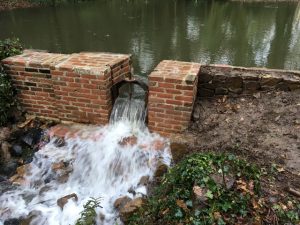By David Pett, former HM Receiver General for Jersey

In 2019 Jersey Round Table approached me, expressing an interest in a conservation project for the restoration and regeneration of Gigoulande Mill Pond.
The Mill Pond lies 300m north of Gigoulande Mill alongside La Route de la Vallée in St Mary. The mill itself was abandoned at the end of World War II and as a result the mill pond fell into disrepair, silted up and became overgrown with brambles, weeds, sycamores and scrub willow. The sluice gate had disappeared and the dam wall had largely collapsed. It had become an ecological desert with little variety of flora or fauna.

After consultations with the appropriate experts, Jersey Round Table commenced work early in 2020 with the felling and clearing of sycamores and scrub willow. This exposed the dilapidated state of the dam wall and the extent of the silted up pond bed.

It was decided that the ultimate water level should not extend to the roadside wall as it had probably done in the mill’s heyday but to stop some 2.5m short. This would prevent any possibility of undermining the main road and to allow a footpath alongside the pond edge for maintenance and recreational purposes.
Specialist stone masons were employed to repair the dam wall whilst the pond bed was cleared and reshaped. Several loads of rubbish were removed from the pond bed which, at some time, had become an informal dumping ground.
A sluice gate was obtained at a local auction sale and put in place. The pond filled up to an acceptable level and was officially opened by the Lieutenant Governor Air Chief Marshal Sir Stephen Dalton in December 2020. At that time it was acknowledge that further work was needed and the whole site looked very raw.

Unfortunately the sluice gate was not complete or fully functional but was used over the winter. This was a period of exceptional rain fall and a blockage at the gate rapidly caused the pond to overfill. The stone masons were re-engaged in the spring to create a spillway and this seems to have relieved the water level problem. It is hoped that the sluice gate can be made fully operational in the near future. Further general work is still needed around the pond and is progressing slowly. It is an ongoing project.
So what has been achieved? Comparing some before and after photographs it is clear that the ecology of the whole site has been vastly improved. The area has been opened up and is now light and airy. This has allowed the mature oaks surrounding the pond to be shown off to their full effect. At the margins aquatic plants are re-establishing and insect life has increased. Damsel and Dragon flies have been observed together with a number of varieties of butterflies. Small fish have even been observed in the pond although no one knows how they got there. A pair of mallard ducks have nested and raised their second brood of the year.
What are the aims for the future? Firstly, to create a calm and peaceful spot for pedestrians walking up the valley and it is hoped to have one or two picnic benches installed by next spring. Secondly, to continue the clearance of unwanted debris so as to continue the ecological enhancement of the area. Thirdly, to create the maintenance path running alongside the pond and perhaps in due course link this to the general north-south-path along St Peter’s valley.





